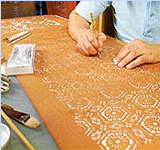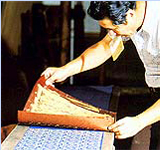南部古代型染元 蛭子屋 (有)小野染彩所は染色製品の製造販売を専門とする会社です。
Nanbukodaikatazomemoto Ebisuya Onosensaisyo
English Guide CONCEPT
English Guide
Nanbukodaikatazomemoto Ebisuya Onosensaisyo
Original Nambu Stencil Dyeing
Ebisuya
Ono Hand Dyed Fabrics
10-16 Zaimoku-cho.Morioka-chi
The history of old fashioned stencil dyeing can be thought of as beginning in the Muromachi Period (1336 to 1573),originating in the dyeing of family crests in the individual soldier's banners, commander's standards and "curtains" made for generals. Therefore, in each general's territory, there was stencil dyeing for that territory's individual pattern.
For
example, there are Nabeshima-gata, Shimazu-gata, Kaga-zome and
Kishu-gata patterns as well as the
pattern for the Shogun,etc.
Among these, Ebisuya, the dyers for
the Nambu family,a branch of the Takeda family, has one of the oldest
traditions,going back to Koshu-Nambu-go (Yamanashi Prefecture) where
the Nambu family originated.
The Nambu-gata patterns that came out of this tradition continue today and are called "the original Nambu-gata patterns."
In
other words, I, Nobuaki Ono,am the 18th generation, and we have an almost 400 year history.
We moved to Morioka when the
castle of Lord Nambu was built here, and we have been doing business
at our present location
for about 350 years. We can be sure of
this by consulting our family tree, which shows the 5th year of the
Kanei Period (1628).
The special characteristics of Nambu-gata
are dynamic patterns with delicate expression and graceful flow. In
short,
-1-
It
can be said that the heroic nature of the Nambu and the art loving
personalities of the Lords of Nambu Castle penetrated even to the
common people.
This work of mine is fostered by this historical
tradition and has been handed down from my ancestors.I always make an
effort to revive the wonderful styles and patterns of my ancestors.
If this is transmitted to future generations as a small light in
Japanese culture, I will be very happy.
Making
of the Stencil and Dye-proof Paste
The process of old fashioned
Nambu stencil dyeing is in short just what the words say; based on a
stencil, a paste is applied to the cloth and an undyed pattern is
left behind.
Cloth dyed in this way is of course used for
kimonos, as well as purses,card cases, noren, obi, table
centers,table cloths, various types of bags, and many other
things.
One feels the naturalness and heroic movement seen in
the gracefulness of this classic art, and may I say a unique feeling,
a nuance maybe, or something like that
that comes
out of the stencil dyeing.
If I begin telling
how the stencils are made, I would say they start with the design.
After the design is finished, it is placed on the stencil paper, and
the pattern is cut out based on it. This is one of the most important
techniques in stencil dyeing, and it requires long training, patience
and effort.

The four stencil cutting techniques are as follows:
Tsukibori: Using
the point of the knife, the pattern is cut out by pushing the knife forward.
Nomibori:
The tip of the chisel (nomi) is a half circle. Using this tip against
the paper, a circular shape is cut out by spinning the
tool.
Dogubori: The tip of the chisel is circular, square, or
one of a number of other shapes, and that shape is formed in the
stencil by means of a stabbing motion.
Hikibori: This is also
called shimabori. A straight edge is placed on the stencil paper, and
a stripe is cut by pulling the knife towards oneself.
Besides
these, some-e (picture dyeing) techniques are among those with a long
history. In short, the picture is drawn by squeezing the dye-proof
paste out of a tube.
There
are coloring and painting techniques for the pictures, and the
pictures are
completed using them. This is one of the three
techniques for dyeing with uncolored spots that originated in the
Tempyo Period (710 to 794), and can be thought of as descending from
wax printing (batik).
At that time, beeswax is said to have been used, but in the Momoyama Period (16th century), it is said to have been replaced with a paste.
At
present, there are very few people doing this kind of dyeing, and it
is very rare.
The following is a brief explanation of the
dye-proof paste used at our factory, for your reference:
A small
amount of rice bran is added to rice
flour, and it is kneaded with the proper amount of hot water until it
becomes sticky and elastic. It is then steamed for about two
hours,and it becomes stronger and thicker. So that it does not get
too hard, a small amount of hot water is added and it is kneaded with
a stick and stored that way.
On the other hand,a proper amount of rice bran is added to a small amount of refined rice bran and mixed with the base paste that has been stored in a separate container to make the dye-proof paste.
At
that time it is important that salt be added to preserve the
softness, so the paste will not dry out and crack.
Usually a
mixture of three parts paste to two parts of the rice bran product is
thought to be proper for standard stencil dyeing. Of course,
depending on what it is used for and the fineness or coarseness of
the pattern, the amounts in the mixture must be adjusted.
Next,
here is a simple explanation of the dyeing process:
(1) Prior to
dyeing, the cloth is processed and dried so that the weaving paste
and oils in the thread are removed.
(2) The dye-proof paste is applied to the dried cloth using the stencil.

(3) Next is Jiire: Soy bean juice is applied to the material to which the paste has been applied in order to facilitate the penetration of the dye.

(4) The dye is applied with a brush, and if variation in shade is needed, accents are made with the proper dyes. After dyeing,
the piece is dried and washed to complete the
process.
However, there are many other methods, and this one is
just an example.
Mukai-zuru
(facing cranes pattern)
This is a diamond shaped pattern made
with the Mukai-zuru, the crest of Lord Nambu. This diamond shaped
crane pattern is a pattern peculiar to old fashioned Nambu stencil
dyeing.
![]()
Senba-chidori
(thousand plover pattern)
Ebisuya Sanuemon, the dyer who went to
Sannohe with Nambu Yoshimitsu, the lord of Koshu-Nambu-go, is said to
have cut out this pattern after having been fascinated by the beauty
of a flock of plover at the seaside. This is a pattern peculiar to
old fashioned Nambu stencil dyeing.
![]()
Nambu
Hagi (Nambu Japanese bush clover pattern)
This is thought to be
the oldest Nambu stencil dyeing pattern.
One can see the
beautiful flow of lines within a disorderly pattern.
![]()
南部古代型染元 蛭子屋 (有)小野染彩所
"Nanbukodaikatazomemoto Ebisuya Onosensaisyo”
Zipcode-jp 020-0063
10-16 Zaimoku-cho .Morioka-shi
SITE TOP
バナースペース
南部古代型染元 蛭子屋
(有)小野染彩所
Nanbukodaikatazomemoto
Ebisuya Onosensaisyo
020-0063
岩手県盛岡市材木町10-16
Zipcode-jp 020-0063
10-16 zaimoku-cho,morioka-shi,
iwate-ken,japan
E-mail
info@katazome.jp
offical-website
https://katazome.jp